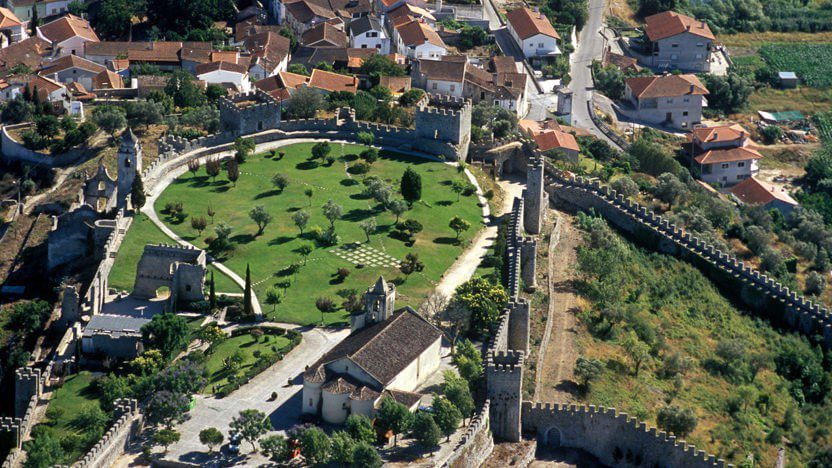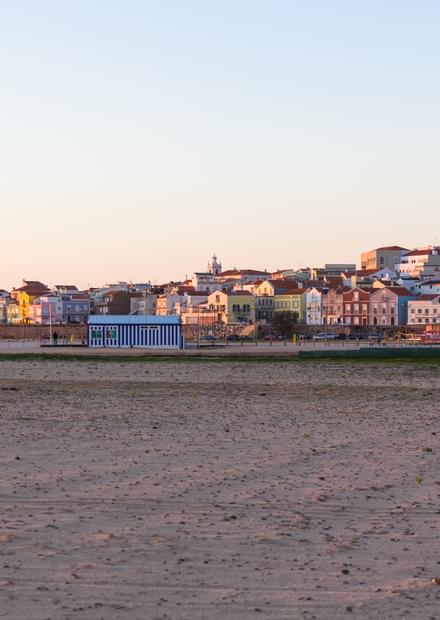Dominating the valley where the Mondego River runs, with endless rice fields, the town of Montemor-o-Velho is characterized by its imposing castle, the main fortress of Low Mondego during Medieval times.
This extensive land has been successively occupied since Roman times and when the Arabs first settled during the 8th century, the Mondego lands became a constant stage of intense fights between Muslims and Christians.
After the Catholic Reconquista and the Portuguese independence, Montemor-o-Velho and its majestic fortress were the stage of countless events of Portuguese History. The stones of the castle have defended the valley and the river which fertilizes it and have received Kings and Infantas, being closely associated with tales born out of the people’s traditional imagination.
Al-Mansur fortress and the medieval castle
In 911, al-Mansur conquered Montemor-o-Velho and it might have been then that an Islamic fortification with a mosque was built. There is almost nothing left from this ancient space and the castle which now rises upon the Mondego valley is the work of several medieval campaigns. In 1064, after Coimbra was conquered, Montemor-o-Velho was taken over by the Christians and King Alfonso VI of Castile might have rebuilt the defensive structure. During the same period, inside the walls, the Santa Maria da Alcáçova Church was founded and it would be altered many times throughout the following centuries.
Under Afonso Henriques and Sancho I, the structure of the fortress was reinforced because Montemor kept its geo-strategic importance after the Portuguese independence. Infantas Teresa and Mafalda ordered the house inside the castle to be renovated and transformed it into a typical manor house.
The fortress was the centre of many fights throughout the following centuries. King Afonso II didn’t agree with his father’s will which gave the castle to his two sisters, Teresa and Mafalda and it was necessary for the Pope to intervene in order to settle this issue. Later, it would again become the centre of new conflicts, first between Sancho II and Afonso III and then between Prince Afonso and his father, King D. Dinis. Because of its military importance for the Portuguese territory, the regent Prince Peter chose it as his personal palace.
The Destiny of Inês de Castro
Montemor-o-Velho Castle was also the stage of one of the most tragic events in History. It was here that, during the first days of 1355, King Afonso IV and his counsellors met to discuss the danger the marriage between Prince Peter and Inês de Castro would represent to Portuguese politics. She was the daughter of one of the most powerful nobleman of Castile and was living with the heir to the throne since his wife had died in 1345.
The court was not pleased with this connection, especially because Inês’ brothers had great influence over the future King and there was a possibility that the couple’s illegitimate children would one day inherit the throne. Afonso IV was convinced that the relationship between Peter and Inês was an affair of State and that Castro would threaten Portuguese independence… Thus, the fate of Inês was decided and she would be murdered a few days later at Santa Clara Palace in Coimbra, following the King’s order.
Infantas Manor and Tea House
When you visit the castle, you should also enjoy the view of the Mondego rice fields while you drink a cup of tea at the Infantas Manor and Tea House, built on the ruins of the old manor that used to exist inside the fortification. This is a relaxed and modern space with glass walls and a wide terrace perfectly integrated into the walls which will provide you sweet and comforting afternoons.
Paul do Taipal
The Special Protected Zone of Paul do Taipal, located on the plateau of Lower Mondego River in the council of Montemor-o-Velho, between Figueira da Foz and Coimbra, is a 233-ha wetland, divided in two different areas: a swampy area and an involving agricultural area.
The marshy area is inhabited by reeds, bulrushes, alders, ash-trees, poplars, water lilies, and chickweed, whereas the surrounding area is occupied by irrigated and rainfed tree crops.
The Taipal can be seen all year round and among the most frequent species it is worth highlighting: red heron, purple heron, spoonbill, cayman, curlew, teal, black ibis, mallard duck, great egret, Northern goshawk, booted eagle, reed weasel, nightingale, among others.
There are also birds, such as: the common pelican and the yellow-billed warbler but we rarely find them.
A true sanctuary of fauna and flora to discover!
Location
Google Maps






















